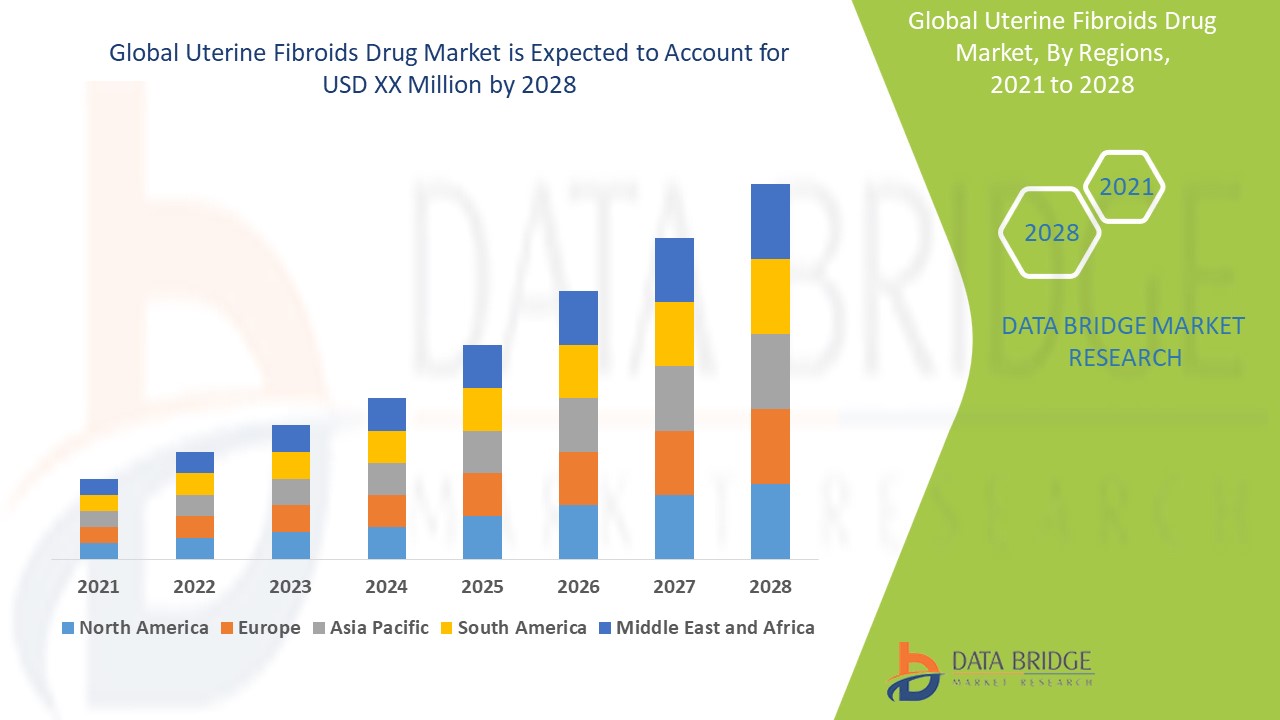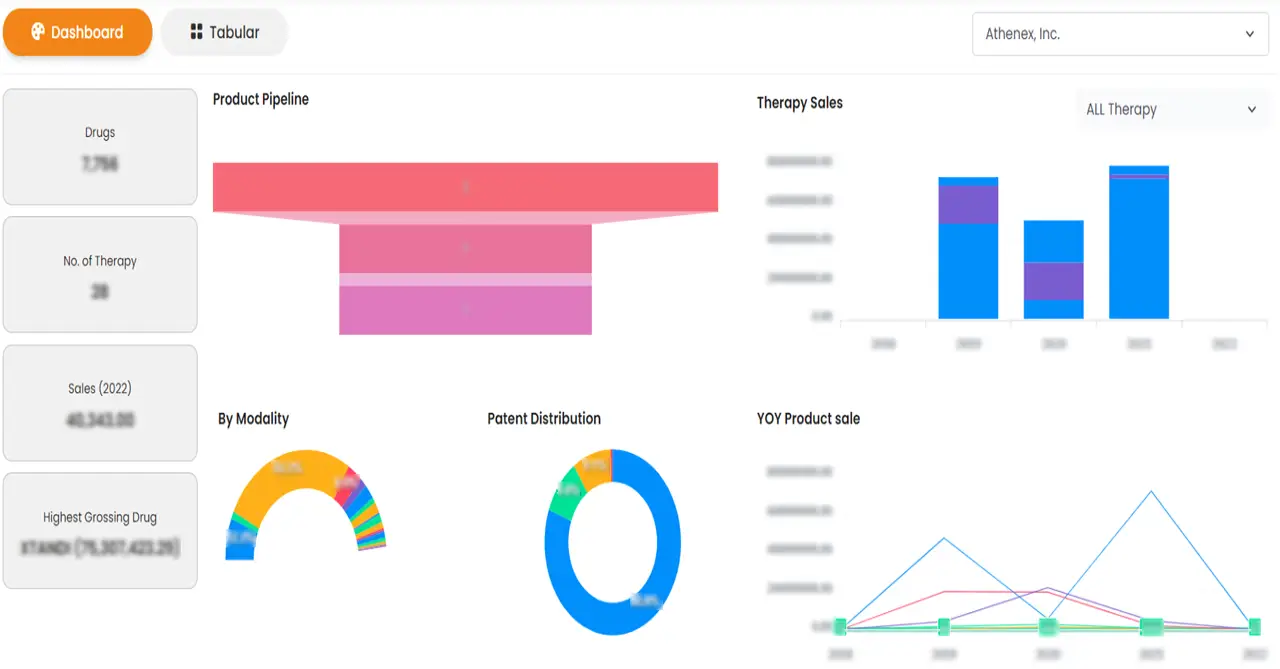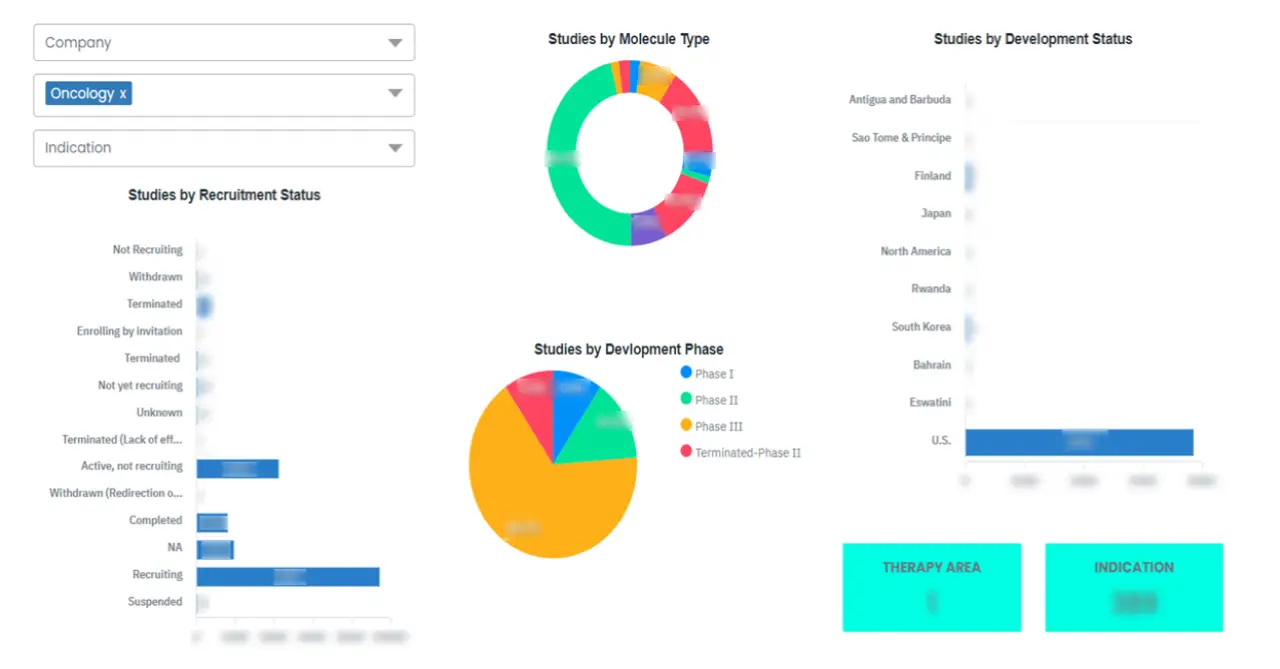世界の子宮筋腫治療薬市場の規模、シェア、トレンド分析レポート
Market Size in USD Billion
CAGR :
% 
 USD
1.64 Billion
USD
3.33 Billion
2024
2032
USD
1.64 Billion
USD
3.33 Billion
2024
2032
| 2025 –2032 | |
| USD 1.64 Billion | |
| USD 3.33 Billion | |
|
|
|
|
世界の子宮筋腫薬市場のセグメンテーション、タイプ別(漿膜下筋腫、粘膜下筋腫、壁内筋腫、有茎性筋腫)、作用機序別(GnRHアゴニスト、ステロイド、避妊薬、NSAID、ビタミン)、薬剤タイプ別(プロゲステロン、レボノルゲストレル、メフェナム酸、ラロキシフェン、その他)、診断別(超音波、臨床検査、画像検査)、治療別(投薬、栄養補助食品、手術)、投与経路別(経口、静脈内、その他)、エンドユーザー別(病院、在宅ケア、専門クリニック、その他) - 2032年までの業界動向と予測
子宮筋腫治療薬市場分析
子宮筋腫治療薬市場は、生殖年齢の女性に多く見られる子宮筋腫の問題に対処するため、外科的治療の代替となる薬理学的選択肢の進歩により拡大しています。主な成長要因としては、低侵襲性ソリューションの需要増加、症状管理の改善、生殖能力の温存などが挙げられます。新しいホルモン療法、特に選択的プロゲステロン受容体モジュレーター (SPRM) とゴナドトロピン放出ホルモン (GnRH) 拮抗薬は、手術なしで痛み、出血、筋腫の大きさを軽減する選択肢を提供することで、市場に大きな影響を与えています。ただし、これらの薬剤の長期的な安全性と副作用プロファイルは、市場で受け入れられるために重要です。研究開発は、副作用を最小限に抑えて効果的に症状を緩和する治療法に引き続き重点を置いており、個々の患者のニーズに応えるより安全で非侵襲的なソリューションへの傾向を反映しています。認知度の高まりと研究への投資の増加により、市場の成長が促進され、製薬会社はより利用しやすい子宮筋腫管理オプションに対する大きく変化する需要に対応できるようになると予想されます。その結果、子宮筋腫治療薬市場は、この症状を管理するための非外科的代替手段を求める女性が増えるにつれて、着実に成長すると予想されます。
子宮筋腫治療薬市場規模
世界の子宮筋腫治療薬市場規模は、2024年に16億4,000万米ドルと評価され、2025年から2032年の予測期間中に9.20%のCAGRで成長し、2032年までに33億3,000万米ドルに達すると予測されています。市場価値、成長率、セグメンテーション、地理的範囲、主要プレーヤーなどの市場シナリオに関する洞察に加えて、Data Bridge Market Researchがまとめた市場レポートには、詳細な専門家分析、患者の疫学、パイプライン分析、価格分析、規制枠組みも含まれています。
子宮筋腫治療薬市場の動向
「非外科的ホルモン療法への傾向の高まり」
子宮筋腫治療薬市場は、症状や筋腫の大きさに効果的に対処する非外科的ホルモン療法への傾向により、著しい成長を遂げています。これは特に、より安全で便利な治療オプションを提供する選択的プロゲステロン受容体モジュレーター(SPRM)とGnRH拮抗薬の採用増加によって推進されています。たとえば、ウリプリスタル酢酸塩などのSPRMは、手術に代わる非侵襲的な選択肢となるため、筋腫関連の出血や痛みを抑えるためにヨーロッパで人気があります。市場は、個別化された低侵襲の筋腫管理に対する需要の高まりを反映しており、有効性と安全性の両方を優先する医薬品イノベーションへの継続的な投資を促しています。
レポートの範囲と子宮筋腫治療薬市場のセグメンテーション
|
属性 |
子宮筋腫治療薬の主要市場洞察 |
|
対象セグメント |
|
|
対象国 |
北米では米国、カナダ、メキシコ、ヨーロッパではドイツ、フランス、英国、オランダ、スイス、ベルギー、ロシア、イタリア、スペイン、トルコ、その他のヨーロッパ、ヨーロッパでは中国、日本、インド、韓国、シンガポール、マレーシア、オーストラリア、タイ、インドネシア、フィリピン、アジア太平洋地域 (APAC) ではその他のアジア太平洋地域 (APAC)、中東およびアフリカ (MEA) の一部としてサウジアラビア、UAE、南アフリカ、エジプト、イスラエル、中東およびアフリカ (MEA) の一部としてその他の中東およびアフリカ (MEA)、南米の一部としてブラジル、アルゼンチン、その他の南米 |
|
主要な市場プレーヤー |
GSK plc (英国)、F. Hoffmann-La Roche Ltd (スイス)、Pfizer Inc (米国)、Novartis AG (スイス)、Bristol-Myers Squibb Company (米国)、Sanofi (フランス)、Teva Pharmaceutical Industries Ltd. (イスラエル)、Amgen Inc (米国)、Medtronic (アイルランド)、Endo, Inc. (米国)、Viatris Inc. (米国)、Sun Pharmaceutical Industries Ltd (インド)、Hologic, Inc (米国)、Smith + Nephew (英国)、Merck & Co., Inc (米国)、AbbVie Inc. (米国)、Bayer AG (ドイツ)、Koninklijke Philips NV (オランダ)、IceCure Medical (イスラエル) |
|
市場機会 |
|
|
付加価値データ情報セット |
Data Bridge Market Research がまとめた市場レポートには、市場価値、成長率、セグメンテーション、地理的範囲、主要プレーヤーなどの市場シナリオに関する洞察に加えて、専門家による詳細な分析、患者の疫学、パイプライン分析、価格分析、規制の枠組みも含まれています。 |
子宮筋腫治療薬市場の定義
子宮筋腫治療薬は、子宮筋腫の症状を管理したり、筋腫の大きさを小さくしたりするために開発された薬です。子宮筋腫は子宮にできる非癌性の腫瘍で、痛み、月経過多、不妊症の原因となることがあります。これらの薬には、選択的プロゲステロン受容体調節薬 (SPRM) やゴナドトロピン放出ホルモン (GnRH) 拮抗薬などのホルモン療法が含まれることが多く、ホルモンレベルを変化させて症状を緩和し、筋腫を小さくする効果があります。これらの治療は患者に非外科的治療の選択肢を提供し、筋腫治療薬市場の成長に貢献しています。
子宮筋腫治療薬市場の動向
ドライバー
- 子宮筋腫の発生率増加
子宮筋腫の発症率の上昇は、標的療法の開発にとって重要な市場推進力となっています。研究によると、女性の約 70~80% が 50 歳までに筋腫を経験し、アフリカ系アメリカ人女性が不釣り合いに多く、この年齢までに約 80% の女性が筋腫を発症します。米国産科婦人科学会 (ACOG) によると、これらの良性腫瘍は、月経過多、骨盤痛、生殖問題など、さまざまな症状を引き起こす可能性があり、罹患した女性の生活の質に重大な影響を与えます。筋腫のある女性の約 30% が治療を必要としているという事実によって、効果的な治療オプションの必要性がさらに強調され、医薬品開発者が大規模な患者層の需要を満たす大きなチャンスがあることが浮き彫りになっています。この罹患率の上昇は、非侵襲性および薬物療法の研究開発への投資の重要性を強調し、子宮筋腫医薬品セクターの市場成長を促進します。
- 高齢女性人口の増加
子宮筋腫の発生率上昇には、女性人口の高齢化が大きく影響しています。これは、年齢とともに良性腫瘍を発症するリスクが高まるためです。研究によると、35歳までに女性の約30%に筋腫が見られ、50歳までにこの数字は70%近くに上昇します。世界人口は高齢化し続けており、特に先進国では、高リスク年齢層の女性の数が増えると予想され、効果的な治療オプションの需要がさらに高まります。この傾向は、標的を絞った医薬品療法の必要性を強調しており、医療システムが人口動態の変化に適応するにつれて、子宮筋腫の薬物市場は大幅な成長を遂げると見込まれます。
機会
- 医療技術の進歩
Advancements in medical technology are significantly enhancing treatment options for uterine fibroids, particularly through innovations in drug development and minimally invasive surgeries. For instance, the introduction of selective progesterone receptor modulators (SPRMs), such as ulipristal acetate, has revolutionized the medical management of fibroids by providing a non-surgical option that effectively reduces fibroid size and alleviates symptoms. Additionally, procedures such as uterine artery embolization (UAE) and magnetic resonance-guided focused ultrasound (MRgFUS) are gaining traction as minimally invasive alternatives to traditional surgery, allowing for quicker recovery times and reduced hospital stays. These innovations improve patient outcomes and expand the market for uterine fibroid treatments by catering to women seeking effective, less invasive options, presenting a significant market opportunity.
- Increasing Government Initiatives and Support
Government initiatives and support for women's health are crucial in promoting the development of effective treatments for conditions such as uterine fibroids. For instance, programs funded by the National Institutes of Health (NIH) and similar organizations focus on women's health research, providing grants that facilitate the exploration of innovative therapies and treatment protocols for uterine fibroids. Such funding has led to increased research into non-invasive treatment options and improved clinical guidelines. Additionally, public health campaigns aimed at raising awareness about uterine fibroids help to destigmatize the condition, encouraging more women to seek treatment. This supportive environment fosters innovation in drug development and creates a favorable market landscape, driving growth in the uterine fibroid treatment sector as stakeholders align with government priorities to enhance women's health outcomes.
Restraints/Challenges
- High Costs Associated with Uterine Fibroids Treatment
High costs associated with uterine fibroid treatment pose a significant challenge in the market, often deterring patients from seeking necessary care. The financial burden includes expenses for medications, diagnostic procedures, and potential surgical interventions, which can accumulate quickly. For instance, the average cost of a myomectomy, a common surgical procedure for fibroids, can exceed several thousand dollars, depending on the healthcare facility and geographical location. Moreover, insurance coverage for treatment varies widely, with some plans offering limited benefits for certain procedures or medications. This inconsistency can create financial barriers, leaving many women unable to afford optimal care. For instance, while drugs such as ulipristal acetate (Esmya) are prescribed for managing fibroids, they may not be covered by all insurance plans, leading to out-of-pocket expenses that discourage treatment. As a result, the high costs and variability in insurance coverage significantly impact patient access to effective treatments for uterine fibroids, hindering overall market growth.
- Side Effects and Safety Concerns
The side effects and safety concerns associated with uterine fibroid treatments, particularly those involving GnRH agonists (gonadotropin-releasing hormone agonists), represent a significant challenge for the drug market. While GnRH agonists such as leuprolide acetate are effective at reducing fibroid size and managing symptoms, their use is frequently limited to short-term treatment due to severe side effects such as bone density loss, which can increase the risk of osteoporosis if used long-term. Additionally, patients may experience menopausal-like symptoms, including hot flashes, night sweats, and mood swings, which can be difficult to manage and may deter continued use. Cardiovascular risks are also a concern for some patients, as hormone alterations can affect heart health. These adverse effects reduce patient adherence to these medications and drive demand for safer, alternative therapies. This ongoing need for safer treatment options constrains the growth of the current drug market, as many patients and healthcare providers seek non-hormonal or less invasive alternatives to avoid the safety risks associated with conventional drug therapies. Consequently, these side effects create a challenging market landscape by increasing the demand for innovative treatments with improved safety profiles, thereby slowing the uptake and retention of existing drugs.
This market report provides details of new recent developments, trade regulations, import-export analysis, production analysis, value chain optimization, market share, impact of domestic and localized market players, analyses opportunities in terms of emerging revenue pockets, changes in market regulations, strategic market growth analysis, market size, category market growths, application niches and dominance, product approvals, product launches, geographic expansions, technological innovations in the market. To gain more info on the market contact Data Bridge Market Research for an Analyst Brief, our team will help you take an informed market decision to achieve market growth.
Uterine Fibroids Drug Market Scope
The market is segmented on the basis of type, mechanism of action, drug type, diagnosis, application, treatment, route of administration, and end users. The growth amongst these segments will help you analyse meagre growth segments in the industries and provide the users with a valuable market overview and market insights to help them make strategic decisions for identifying core market applications.
Types
- Subserosal Fibroids
- Submucosal Fibroids
- Intramural Fibroids
- Pedunculated Fibroids
Mechanism of Action
- GnRH Agonists
- Steroids
- Contraceptives
- NSAIDs
- Vitamins
Drugs Type
- Progesterone
- Levonorgestrel
- Mefenamic Acid
- Raloxifene
- Others
Diagnosis
- Ultrasound
- Lab Tests
- Imaging Tests
Treatment
- Medication
- Dietary Supplements
- Surgery
Route of Administration
- Oral
- Intravenous
- Others
End User
- Hospitals
- Homecare
- Specialty Clinics
- Others
Uterine Fibroids Drug Market Regional Analysis
The market is analysed and market size insights and trends are provided by country, type, mechanism of action, drug type, diagnosis, application, treatment, route of administration, and end users as referenced above.
The countries covered in the market report are U.S., Canada and Mexico in North America, Germany, France, U.K., Netherlands, Switzerland, Belgium, Russia, Italy, Spain, Turkey, Rest of Europe in Europe, China, Japan, India, South Korea, Singapore, Malaysia, Australia, Thailand, Indonesia, Philippines, Rest of Asia-Pacific (APAC) in the Asia-Pacific (APAC), Saudi Arabia, U.A.E., South Africa, Egypt, Israel, Rest of Middle East and Africa (MEA) as a part of Middle East and Africa (MEA), Brazil, Argentina and Rest of South America as part of South America.
North America leads the uterine fibroids drug market, primarily due to the increasing prevalence of patients diagnosed with uterine fibroids. This growth is further fueled by the availability of effective and innovative treatment options tailored for women. Additionally, the high purchasing power of women in the region enables greater access to these therapies. Lifestyle changes, particularly in dietary habits, also contribute to the rising incidence of this condition, driving demand for targeted medications.
Asia-Pacific is poised for significant growth in the uterine fibroids drug market, driven by heightened awareness of the condition among the population. Favorable government policies aimed at improving women's health and increasing access to treatments further support this expansion. Additionally, the modernization of healthcare infrastructure in developing countries such as China and India facilitates the delivery of advanced medical services. The burgeoning medical tourism industry in these nations also attracts patients seeking effective therapies for uterine fibroids, contributing to the market's growth potential.
The country section of the report also provides individual market impacting factors and changes in regulation in the market domestically that impacts the current and future trends of the market. Data points such as down-stream and upstream value chain analysis, technical trends and porter's five forces analysis, case studies are some of the pointers used to forecast the market scenario for individual countries. Also, the presence and availability of global brands and their challenges faced due to large or scarce competition from local and domestic brands, impact of domestic tariffs and trade routes are considered while providing forecast analysis of the country data.
Uterine Fibroids Drug Market Share
The market competitive landscape provides details by competitor. Details included are company overview, company financials, revenue generated, market potential, investment in research and development, new market initiatives, global presence, production sites and facilities, production capacities, company strengths and weaknesses, product launch, product width and breadth, application dominance. The above data points provided are only related to the companies' focus related to market.
Uterine Fibroids Drug Market Leaders Operating in the Market Are:
- GSK plc (U.K.)
- F. Hoffmann-La Roche Ltd (Switzerland)
- Pfizer Inc (U.S.)
- Novartis AG (Switzerland)
- Bristol-Myers Squibb Company (U.S.)
- Sanofi (France)
- Teva Pharmaceutical Industries Ltd. (Israel)
- Amgen Inc (U.S.)
- Medtronic (Ireland)
- Endo, Inc. (U.S.)
- Viatris Inc. (U.S.)
- Sun Pharmaceutical Industries Ltd (India)
- Hologic, Inc (U.S.)
- Smith + Nephew (U.K.)
- Merck & Co., Inc (U.S.)
- AbbVie Inc. (U.S.)
- Bayer AG (Germany)
- Koninklijke Philips N.V. (Netherlands)
- IceCure Medical (Israel)
Latest Developments in Uterine Fibroids Drug Market
- 2023年10月、革新的なヘルスケア企業である住友製薬カナダ社と製薬会社ファイザーカナダ社は、カナダ保健省がMYFEMBREE(レルゴリクス、エストラジオール、ノルエチンドロン酢酸塩の錠剤)の適合通知(NOC)を発行したことを発表しました。この薬は、閉経前女性の中等度から重度の子宮内膜症の痛みの治療薬として承認されています。これに先立ち、2023年9月22日、カナダ保健省は、閉経前女性の子宮筋腫による月経過多の管理薬としてMYFEMBREEを承認しました。この経口併用療法は1日1回服用し、女性に子宮内膜症と子宮筋腫の症状を緩和する新しい治療オプションを提供します。
- 2022年6月、バイオ医薬品企業であるオブスエバSAは、英国医薬品・医療製品規制庁(MHRA)が、生殖年齢(18歳以上)の成人女性の中等度から重度の子宮筋腫の治療薬として、経口GnRH拮抗薬であるイセルティ(リンザゴリクス)を承認したと発表しました。
- 2022年8月、ファイザー社とマイオバント・サイエンシズ社が共同で開発した製品「MYFEMBREE」が、月経中および月経以外の症状に関連する中等度から重度の痛みの管理薬として米国FDAの承認を受けた。この規制当局の承認により、同製品は市場に投入され、同社の製品ラインナップが強化された。
- 2021年5月、Myovant Sciencesはファイザー社と共同で、米国食品医薬品局(FDA)がMYFEMBREE(レルゴリクス40mg、エストラジオール1mg、ノルエチンドロン酢酸塩0.5mg)を承認したと発表した。これは、閉経前女性の子宮筋腫に関連する月経過多に対する1日1回投与の初の治療薬であり、治療期間は最長24か月である。
- 2020年5月、製薬会社のアッヴィとバイオ医薬品会社のニューロクラインバイオサイエンス社は、米国FDAがORIAHNN(エラゴリクス、エストラジオール、ノルエチンドロン酢酸塩カプセル、エラゴリクスカプセル)を承認したことを明らかにした。ORIAHNNは、閉経前女性の子宮筋腫による月経過多の管理を目的とした、米国FDAが承認した初の非外科的経口薬である。
SKU-
世界初のマーケットインテリジェンスクラウドに関するレポートにオンラインでアクセスする
- インタラクティブなデータ分析ダッシュボード
- 成長の可能性が高い機会のための企業分析ダッシュボード
- カスタマイズとクエリのためのリサーチアナリストアクセス
- インタラクティブなダッシュボードによる競合分析
- 最新ニュース、更新情報、トレンド分析
- 包括的な競合追跡のためのベンチマーク分析のパワーを活用
調査方法
データ収集と基準年分析は、大規模なサンプル サイズのデータ収集モジュールを使用して行われます。この段階では、さまざまなソースと戦略を通じて市場情報または関連データを取得します。過去に取得したすべてのデータを事前に調査および計画することも含まれます。また、さまざまな情報ソース間で見られる情報の不一致の調査も含まれます。市場データは、市場統計モデルと一貫性モデルを使用して分析および推定されます。また、市場シェア分析と主要トレンド分析は、市場レポートの主要な成功要因です。詳細については、アナリストへの電話をリクエストするか、お問い合わせをドロップダウンしてください。
DBMR 調査チームが使用する主要な調査方法は、データ マイニング、データ変数が市場に与える影響の分析、および一次 (業界の専門家) 検証を含むデータ三角測量です。データ モデルには、ベンダー ポジショニング グリッド、市場タイムライン分析、市場概要とガイド、企業ポジショニング グリッド、特許分析、価格分析、企業市場シェア分析、測定基準、グローバルと地域、ベンダー シェア分析が含まれます。調査方法について詳しくは、お問い合わせフォームから当社の業界専門家にご相談ください。
カスタマイズ可能
Data Bridge Market Research は、高度な形成的調査のリーダーです。当社は、既存および新規のお客様に、お客様の目標に合致し、それに適したデータと分析を提供することに誇りを持っています。レポートは、対象ブランドの価格動向分析、追加国の市場理解 (国のリストをお問い合わせください)、臨床試験結果データ、文献レビュー、リファービッシュ市場および製品ベース分析を含めるようにカスタマイズできます。対象競合他社の市場分析は、技術ベースの分析から市場ポートフォリオ戦略まで分析できます。必要な競合他社のデータを、必要な形式とデータ スタイルでいくつでも追加できます。当社のアナリスト チームは、粗い生の Excel ファイル ピボット テーブル (ファクト ブック) でデータを提供したり、レポートで利用可能なデータ セットからプレゼンテーションを作成するお手伝いをしたりすることもできます。














